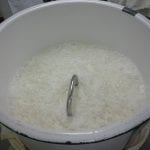 Brewer Number One stood up and faced the crowd. And he talked about his sake. Its lively yet balanced nature is the result of a family of yeasts, one of which was discovered at his brewery several decades ago, he explains. It has contributed to – if not created – the high reputation enjoyed by all of the sake in that region, which only came into sake prominence about 30 years ago.
Brewer Number One stood up and faced the crowd. And he talked about his sake. Its lively yet balanced nature is the result of a family of yeasts, one of which was discovered at his brewery several decades ago, he explains. It has contributed to – if not created – the high reputation enjoyed by all of the sake in that region, which only came into sake prominence about 30 years ago.
Brewer Number Two spoke next. While several years younger than Number One, they are friends (or were, anyway) and both went to Tokyo Agricultural University, the “UC Davis of the sake world.” With his typically dry sense of humor, he jokingly (or so we thought) explained how Number One’s father actually stole that yeast from his brewery to get it all started.
Several days later, Brewer Number One send Brewer Number Two an email that basically e-tore him a new e-asshole. “You should not be saying groundless and untrue things like that; you will confuse and mislead people.”
While it was an email between the two of them, I know Number Two well enough that later, he told me about it, and even showed me the e-tearing email. “I actually thought it was a true story, but it seems I was confusing my anecdotes. I have cleared that up now, but not before Number One laid into me about it.”
What is this all about, this stealing of yeast? How does one steal a naturally occurring micro-organism, and why would one if it is just floating around in the air? I mean, you can’t just stuff it in your pocket and walk out the door, can you? And is it illegal?
 Yeast is massively important to the making of great sake. While they contribute to aromas more than anything else, good yeasts will also ferment strongly and not peter out too early, tolerate high levels of alcohol, yield appropriate levels of acidity that are not too high nor low, and much more.
Yeast is massively important to the making of great sake. While they contribute to aromas more than anything else, good yeasts will also ferment strongly and not peter out too early, tolerate high levels of alcohol, yield appropriate levels of acidity that are not too high nor low, and much more.
While long ago all yeast was naturally occurring, dropping in from the ambient environment, these days brewers get yeast from a few supply chains. These often include local research centers as well. Sometimes, as in the case of Brewer Number One, these yeasts never officially leave the prefecture. And there are those brewers that still use proprietary yeasts, stuff they found in their brewery that does not get released, which is how it all used to be.
And so, if you could get your grubby little paws on the yeast from a great brewery, you could often use it yourself, transposing its main characteristics onto those of your own brewery and sake. And doing so surely would not be illegal, provided that something like “breaking and entering” was not involved.
Nothing like this takes place these days, of course. With so many great yeast strains so easily available, there is no reason to do so. But in the not too distant past, it did happen from time to time.
How does one steal micro-organisms that one cannot see?
Oh, let’s say you visit a brewery whose sake you respect. You just want to pass through, see their setup, ask a question or two and see if you can learn a thing or two from the venerable toji. And as you look down into a tank of fermenting mash and its rising swaths of foam, you smell the aromatic goodness and note how vigorously it is fermenting. Just before you move on to the next tank you let your hand nonchalantly drop down near the surface and scoop up a fingerful of foam. And as you turn to walk away, you casually wipe that off on the underside of the brim of your baseball cap. You just stole their yeast.
When you get back to your own kura, you wash off that area of your cap or sleeve and do what you need to do to revive and let multiply the yeast you know is in that slightly grimy discoloration on your cap. If you do it properly, you will be able to propagate that and eventually use it in your own sake.
While surely not simple, it is far from impossible, and happened often enough that many kura were loathe to let brewing personnel from other companies visit them. Or so I have heard.
 Again, this really does not happen anymore; nor was it ever a huge industry problem. But I have heard about it from several brewers, elevating it above simple legend. Also, just getting a good yeast is not the end of the challenge. A brewer with any new yeast needs to learn its idiosyncrasies during preparation, throughout fermentation, and beyond.
Again, this really does not happen anymore; nor was it ever a huge industry problem. But I have heard about it from several brewers, elevating it above simple legend. Also, just getting a good yeast is not the end of the challenge. A brewer with any new yeast needs to learn its idiosyncrasies during preparation, throughout fermentation, and beyond.
Furthermore, they would not be able to talk about it, and brag how it was painstakingly isolated over several years from amongst ten thousand others by the prefectural research center, or any other such romantic story. Nope.
Nor would it have roots or traceability. All they could really do is call it, “proprietary.” So there are no huge advantage to doing this, nor any real need anymore. It’s a bit like stealing sand from the beach.
But back to our true story, enter Brewer Number Three, nicknamed Mr. Unabashedly Unscrupulous. Apparently, he did in fact visit Brewer Number Two years ago and did in fact steal their yeast. However, he was not able to successfully reconstitute it, and as such it was all for naught. In time, he ‘fessed up about it; no harm done. But wow. Such audacity.
And, when Brewery Number Two chided Brewer Number One about his father’s supposed heist, it seems he was crossing his wires.
“Yeah, I mixed up my yeast-thievery stories and characters,” he admitted to me later. “I suppose I should check my facts before saying things like that in public…” he conciliatorily conceded.
Again, to be clear: this is not something that happens anymore, and is certainly not a problem in the industry. It is nothing more than a fun little anecdote that goes far to convey the important role that yeast plays in making great sake.
The only thing that we need to remember is that the gift of aromas you enjoy in your sake tonight are driven by the choice of yeast.
~~~~~~~~~~~~~~~~~~~~~~~~~~~~~~~~~~~~~~~~~~~
 Interested in learning more about sake? There are just about seven seats remaining open for Sake Professional Course in Denver, August 28 to 30. Learn more here .
Interested in learning more about sake? There are just about seven seats remaining open for Sake Professional Course in Denver, August 28 to 30. Learn more here .




